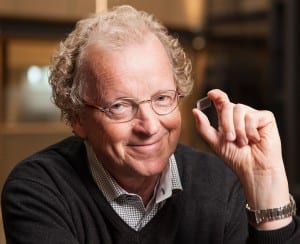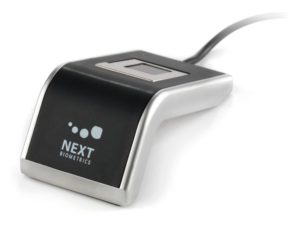FindBiometrics President Peter O’Neill recently had a chance to speak with Tore Etholm-Idsøe, CEO of NEXT Biometrics. The conversation begins with talk of how NEXT is planning to capitalize on the smart card market in 2016. It then goes on to deal with Greenbridge Partners’ recent investment in the company, the advantages NEXT brings to the sensor market, and even how we might see the fingerprint modality make it into the Internet of Things.
Peter O’Neill, President, FindBiometrics (FB): You recently announced that a major focus for NEXT Biometrics is to develop your fingerprint sensors for use in the smart card market. Can you please describe this growth area for us?

Tore Etholm-Idsøe, CEO, NEXT Biometrics: At NEXT Biometrics we are perfectly positioned to create flexible sensors that truly meet all the requirements of ISO standard smart cards. The production process and the materials with which we today make our standard rigid sensors are very similar to what is a required manufacturing flexible sensor. This is a key thing for our manufacturing partner, the US $ 17 billion display giant Innolux. They recognize the NEXT unique positioning in the giant potential smartcard fingerprint sensor market.
Compared with the manufacture of flexible displays it is significantly easier to make a much smaller fingerprint sensor. Furthermore a fingerprint sensor is a fault tolerant device, meaning that you can have a number of faulty pixels in the sensor and it will, as opposed to a display, still work perfectly fine. We are uniquely positioned to bring the first mass market application of flexible electronics to market. Our patented active thermal technology has a unique competitive advantage in this sense.
The material that you need when building capacitive fingerprint sensors used by our leading competitors is silicon. That is a porous material and it will at all relevant smartcard sizes break if you try to bend it. In a smart card context the specifications from the smart card vendors is that you cannot have a silicon component that is larger than 3×3 mm, and it is of course not possible to create anywhere close to a credible fingerprint sensor in that size. You capture virtually no data from the finger at 9 mm2. And it will have absolutely no buffers to cope with everyday “problem finger” issues like cut, worn, dry or wet fingers. An ISO-committee is at present defining the standard of sensors in smart cards going forward and the minimum requirement in size is 169 mm2, about 13×13 mm. That is not possible to do in silicon, but it is possible to do in our material—polysilicon.
FB: Is smart card use of NEXT fingerprint sensors one of the major reasons that Greenbridge Partners decided to invest with your company last fall?
NEXT: Yes. When industrialists Ola Rollén and Melker Schörling invested in NEXT Biometrics their conclusion was that we are best positioned in the smart card. Ola Rollén is privately a major shareholder in Fingerprint Cards and he and his team has deep insights in the field of fingerprint technology. After having studied NEXT for several months, Ola concluded that Fingerprint Cards is the company best positioned in smartphones and that NEXT is best positioned in smart cards. And, we believe he is right.
FB: As you describe the flex technology, it seems to me that, as we read more and more about the Internet of Things, there would be other areas where fingerprint sensors will be populated?
NEXT: Yes, you see it already in a mass market product like the LG SmartWatch, which has a display that is curved at the edges, and that is indeed polysilicon technology. It is produced in a flexible state and then later mounted on a curved rigid shape. We think a lot of new cool devices in the Internet of Things, in smart home context, and maybe even in smart phones, going forward would like to have some kind of shaping of the fingerprint sensor.

FB: We have spoken about the flexibility of your sensors, but what are some of the other main product advantages of NEXT fingerprint sensor products as you see it?
NEXT: In addition to the advantage of physical flexibility, the NEXT fingerprint sensors also have other major advantages over rigid sensors. If you compare apples to apples—when the size is similar and when the performance is similar—our NEXT fingerprint sensors are 70 percent cheaper, putting us at a strong price advantage to our competitors. It was proven in the Madrid Report, a large scale third party test initiated by NEXT with results and state-of-the-art methodology fully published. In the study, more than 180,000 fingerprints were collected and same size sensors from three suppliers were blind tested. The study proved that sensor system performance deteriorates fast when sensor size is reduced. It also documented that NEXT sensors perform in line with competitors’ same size sensors that are 3-to-5 times more expensive. Your readers can download the full report at our website, www.NextBiometrics.com, with a link to it right on our homepage. Today NEXT is the only fingerprint sensor supplier that offers such documentation of performance.
So, there are two major messages we want to send. The size determines not only the quality of the sensor, but also 80 percent or so of the cost structure. Even when you compare our full size 201mm2 fingerprint sensor to the medium sized one like the one in the Huawei phones which is only 92 mm2, we are still cheaper in cost.
This means that in order to get down to mass market acceptable price levels we don’t need to make any compromises on security and convenience.
FB: So how about smartphones—why are the small sensors dominating this market?
NEXT: Apple today defines the volume smartphone segment. Their sensor is small and implemented to add user convenience only. Due to its small size, a significant percentage of any population will have difficulties using it—they will have lot of false rejections. Because of this, users will have to be offered immediate access to a PIN-code or password or an alternative app. Consequently, the smartphone is of course not more secure than these pin-codes, passwords or alternative apps. This is the reason small sensors are never accepted in quality dependent devices or applications. Our sweet spot in smartphones are niche phones targeting higher end applications like voting or access to highly secure databases. Here you want to have true proof of user authenticity, and then a full-sized and low-cost sensor is required. This is because such applications require the sensor to work both conveniently and securely for close to 100 percent of the user group, and that is not possible using a small sensor.
So, our focus is on quality dependent markets, we do not target the small sized smartphone segment, which by the way has already become very crowded. We think however, it is likely that the next iPhone out in September 2016, the iPhone 7, may come with a larger sensor. If that happens, then Apple will have changed the game again. So when it comes to smartphones we have chosen to wait and see what happens.
FB: What else can we expect to see from your company in 2016?

NEXT: A lot of activities and progress in our strongholds—the quality dependent markets. In the traditional markets—doors, payment terminals, time and attendance, etc., we are going for replacement opportunities here, as we are cheaper than the competition. In the smartphones we will concentrate on the high end as I described, waiting for Apple maybe to change the smartphone game again.
In notebooks and tablets NEXT Biometrics is already one of the major players. We have secured one of the top three players, Dell, and anticipate securing more
The market we think that will be our largest market segment is in new what we label as “NEXT-Enabled” markets; typically small devices, Internet of Things, smart home concepts and of course the huge smart card markets.
In these markets/ applications the sensor needs to be inexpensive and as opposed to smartphones and tablets there is no way for people to enter a password. You simply cannot offer these types of secure applications unless you have a fingerprint sensor that is capable of conveniently serving close to 100 percent of the targeted market. Brand name players in several industries are working on new concepts and these kinds of markets offers great opportunity for NEXT.
FB: Tore, thank you very much for filling us in on the progress of NEXT over the past year and I look forward to catching up with you at the Mobile World Congress in Barcelona in 2 weeks.
NEXT: In Barcelona, we will launch a great new product for the NEXT-Enabled small devices. I look forward to see you there Peter.

Follow Us